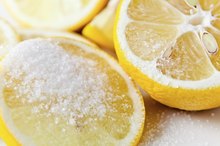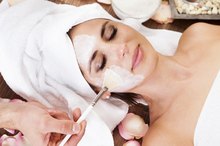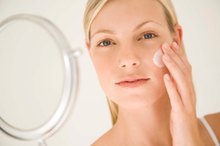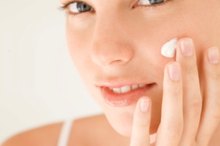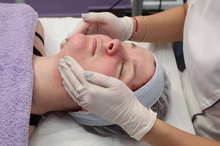What does fact checked mean?
At Healthfully, we strive to deliver objective content that is accurate and up-to-date. Our team periodically reviews articles in order to ensure content quality. The sources cited below consist of evidence from peer-reviewed journals, prominent medical organizations, academic associations, and government data.
The information contained on this site is for informational purposes only, and should not be used as a substitute for the advice of a professional health care provider. Please check with the appropriate physician regarding health questions and concerns. Although we strive to deliver accurate and up-to-date information, no guarantee to that effect is made.
How to Remove Hyperpigmentation on Your Face
The term hyperpigmentation refers to the dark, discolored patches of skin that occur when melanin is overproduced. According to the American Osteopathic College of Dermatology, reasons for this overproduction include sun exposure, skin damage, hormones and certain medications. The condition is typically harmless, though its appearance on prominent areas of the body--such as the face--can affect your self-esteem. Fortunately, there are several over-the-counter fade creams intended for home use. At-home creams and lotions lighten dark spots over time and offer a less-expensive, less-invasive alternative to professional treatments. Consult a professional to determine one that is suitable for you.
Hydroquinone
Wash your face with soap and lukewarm water, then pat dry. Refrain from using harsh cleansers, as these can dry out and irritate the skin.
Aha Vs. Bha
Learn More
Apply the hydroquinone cream to the treatment area. Rub it in well, making sure that the medication stays within the patches of discoloration. Hydroquinone is a bleaching agent that works by preventing melanin production, according to the book “The Dermadoctor Skinstruction Manual” by Dr. Audrey Kunin 2. It affects both abnormally and normally pigmented skin; therefore, application outside of the intended treatment area can result in spots of lighter-than-average pigmentation.
Wash your hands to remove any remaining hydroquinone. Kunin recommends using the treatment twice a day, once in the morning and once at night. During the day, wear a broad-spectrum SPF 15 sunscreen or moisturizer to prevent hyperpigmented areas from further darkening.
- Wash your face with soap and lukewarm water, then pat dry.
- During the day, wear a broad-spectrum SPF 15 sunscreen or moisturizer to prevent hyperpigmented areas from further darkening.
Kojic Acid
Glycolic Acid & Dark Skin
Learn More
Wash your face with a mild soap. Rinse with tepid water, then dry completely.
Apply a kojic acid fade cream twice a day. Kojic acid is a skin lightener derived from fungus. Like hydroquinone, kojic acid fades hyperpigmentation by stopping the production of melanin. In fact, the Cleveland Clinic recommends kojic acid as an alternative for those who are unable to use hydroquinone.
Wash and dry your hands. Protect the treatment area from the sun with sunscreen or a wide-brimmed hat.
- Wash your face with a mild soap.
- In fact, the Cleveland Clinic recommends kojic acid as an alternative for those who are unable to use hydroquinone.
Glycolic Acid
Cleanse and dry your face.
Apply glycolic acid lotion over your entire face. This ingredient is a chemical exfoliant, meaning it helps remove the top layer of skin without the use of the rough “scrubbers” associated with traditional exfoliators. By encouraging cell turn over, glycolic acid essentially peels away superficial dark marks caused by hyperpigmentation.
Apply a light moisturizer. This will help prevent dryness, one of the side effects of glycolic acid use, says Discovery Health. Glycolic acid products are typically intended for twice daily application, but use the treatment once a day if your skin becomes overly dry. During the day, use a moisturizer that contains an SPF of 15 or higher.
Tips
Both hydroquinone and glycolic acid come in prescription and non-prescription formulations. You can buy 2 percent hydroquinone and 5 percent to 10 percent glycolic acid in stores. However, your doctor may prescribe stronger preparations. Kojic acid is also available over-the-counter in strengths of up to 1 percent.
There is no quick fix for hyperpigmentation, and the use of fade creams, especially those sold over-the-counter, requires time and patience. Even highly concentrated formulas can take several weeks to several months to achieve results, says MayoClinic.com.
Warnings
All three ingredients can cause irritation and sun sensitivity. When using topical fade creams, protect your face from the sun and monitor your skin carefully. Excessive irritation can actually cause discoloration known as post-inflammatory hyperpigmentation, warns Kunin.
- Cleanse and dry your face.
- This ingredient is a chemical exfoliant, meaning it helps remove the top layer of skin without the use of the rough “scrubbers” associated with traditional exfoliators.
Related Articles
References
- Mayo Clinic: Age Spots
- "The Dermadoctor Skinstruction Manual"; Audrey Kunin, M.D.; 2005
- Cleveland Clinic: Understanding the Ingredients in Skin Care Products
- Davis EC, Callender VD. Postinflammatory hyperpigmentation: a review of the epidemiology, clinical features, and treatment options in skin of color. J Clin Aesthet Dermatol. 2010;3(7):20-31.
- Fabbrocini G, Annunziata MC, D'arco V, et al. Acne scars: pathogenesis, classification and treatment. Dermatol Res Pract. 2010;2010:893080. doi:10.1155/2010/893080
- Kubba R, Bajaj AK et al. Postinflammatory Hyperpigmentation in Acne. India Journal of Dermatology, Venereology and Leprology. 2009;75(7):54.
- Sharad J. Glycolic acid peel therapy - a current review. Clin Cosmet Investig Dermatol. 2013;6:281-8. doi:10.2147/CCID.S34029
- Sarkar R, Arora P, Garg KV. Cosmeceuticals for Hyperpigmentation: What is Available? J Cutan Aesthet Surg. 2013;6(1):4-11. doi:10.4103/0974-2077.110089
- Sofen B, Prado G, Emer J. Melasma and Post Inflammatory Hyperpigmentation: Management Update and Expert Opinion. Skin Therapy Lett. 2016;21(1):1-7.
- Leyden J, Stein-gold L, Weiss J. Why Topical Retinoids Are Mainstay of Therapy for Acne. Dermatol Ther (Heidelb). 2017;7(3):293-304. doi:10.1007/s13555-017-0185-2
- Bandyopadhyay D. Topical treatment of melasma. Indian J Dermatol. 2009;54(4):303-9. doi:10.4103/0019-5154.57602
- Decker A, Graber EM. Over-the-counter Acne Treatments: A Review. J Clin Aesthet Dermatol. 2012;5(5):32-40.
- Mohamed Ali BM, Gheida SF, El Mahdy NA, Sadek SN. "Evaluation of Salicylic Acid Peeling in Comparison with Topical Tretinoin in the Treatment of Postinflammatory Hyperpigmentation." Journal of Cosmetic Dermatology. 2017 Mar;16(1):52-60.
- Sarkar R, Parmar NV, Kapoor S. "Treatment of Postinflammatory Hyperpigmentation With a Combination of Glycolic Acid Peels and a Topical Regimen in Dark-Skinned Patients: A Comparative Study." Dermatologic Surgery. 2017 Apr; 43(4):566-573.
- Shokeen D. "Postinflammatory Hyperpigmentation in Patients with Skin of Color." Cutis. 2016 Jan;97(1):E9-E11.
Tips
- Both hydroquinone and glycolic acid come in prescription and non-prescription formulations. You can buy 2 percent hydroquinone and 5 percent to 10 percent glycolic acid in stores. However, your doctor may prescribe stronger preparations. Kojic acid is also available over-the-counter in strengths of up to 1 percent.
- There is no quick fix for hyperpigmentation, and the use of fade creams, especially those sold over-the-counter, requires time and patience. Even highly concentrated formulas can take several weeks to several months to achieve results, says MayoClinic.com.
Warnings
- All three ingredients can cause irritation and sun sensitivity. When using topical fade creams, protect your face from the sun and monitor your skin carefully. Excessive irritation can actually cause discoloration known as post-inflammatory hyperpigmentation, warns Kunin.
Writer Bio
Julia Estrela has been working as a freelance writer since 2008. Her work has appeared in various online publications. Estrela holds a Bachelor of Arts in English with a concentration in creative writing from Connecticut College.



